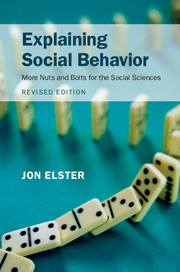Book contents
- Frontmatter
- Dedication
- Contents
- Preface
- I Explanation and Mechanisms
- II The Mind
- III Action
- 10 Constraints: opportunities and abilities
- 11 Reinforcement and selection
- 12 Persons and situations
- 13 Rational choice
- 14 Rationality and behavior
- 15 Responding to irrationality
- 16 Implications for textual interpretation
- IV Interaction
- Conclusion: is social science possible?
- Index
16 - Implications for textual interpretation
from III - Action
Published online by Cambridge University Press: 05 August 2015
- Frontmatter
- Dedication
- Contents
- Preface
- I Explanation and Mechanisms
- II The Mind
- III Action
- 10 Constraints: opportunities and abilities
- 11 Reinforcement and selection
- 12 Persons and situations
- 13 Rational choice
- 14 Rationality and behavior
- 15 Responding to irrationality
- 16 Implications for textual interpretation
- IV Interaction
- Conclusion: is social science possible?
- Index
Summary
In a common view, the scientific enterprise has three distinct parts or branches: the humanities, the social sciences, and the natural sciences. For some purposes, this is a useful way of carving up the field of science, but for other purposes a rigid distinction may prevent cross-fertilization. In this chapter I argue that the humanities and the social sciences have more in common than is usually assumed. (In Chapter 11, I argued that the relevance of natural sciences for the study of society, while not nil, is more limited.) In particular, I shall try to show that interpretation of works of art and explanation are closely related enterprises. In one sense, this seems to me to be self-evident. The production of a work of art is an action, or a series of actions. Like any other action, it is in principle susceptible to explanation in terms of the antecedent mental states of the agent, be they conscious or unconscious. This view of interpretation has the advantage that there is a fact of the matter by virtue of which the interpretation is right if it is right, and wrong if it is wrong. By contrast, interpretations that focus only on “the work itself” have no such external criteria of adequacy. Our proneness to autosuggestion (see Introduction to Part II) and our propensity to search for objective teleology and analogy (Chapter 9) may combine to yield arbitrary interpretations.
A successful work of art is one that can be given a rational-choice explanation, in the sense that the author's choice of means is adequate for his ends. Once again, this seems to be a self-evident proposition. In practice, however, we may not be able to verify this adequacy, except negatively. We may be able to identify a jarring note, but not to explain the choice between several aesthetically plausible options. Even identifying jarring notes – irrational choices – may be impossible if the jarring character itself is sought as an aesthetic effect. For this reason, I shall limit myself to works of art where the criteria are relatively unambiguous: classical (pre-1850) novels and plays defined by the tacit convention that the events and characters that are described could have been real.
- Type
- Chapter
- Information
- Explaining Social BehaviorMore Nuts and Bolts for the Social Sciences, pp. 283 - 294Publisher: Cambridge University PressPrint publication year: 2015



